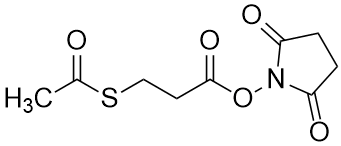S-Acetyl-3-mercaptopropionic acid-N-hydroxysuccinimide ester is widely utilized in research focused on:
- Bioconjugation: This compound serves as a versatile linker in bioconjugation processes, allowing researchers to attach biomolecules like proteins or antibodies to surfaces or other molecules, enhancing the development of targeted therapies.
- Drug Delivery Systems: It is employed in the formulation of drug delivery systems, where its ester functionality can improve the solubility and stability of pharmaceutical compounds, leading to more effective treatments.
- Diagnostics: The compound is used in diagnostic assays, particularly in the development of biosensors that detect specific biomolecules, facilitating early disease detection and monitoring.
- Material Science: In material science, it is applied in the creation of functionalized surfaces that can interact with biological systems, which is crucial for developing biocompatible materials for implants.
- Research on Antioxidants: This chemical is also investigated for its potential antioxidant properties, contributing to studies aimed at understanding oxidative stress and its implications in various diseases.
General Information
Properties
Safety and Regulations
Applications
S-Acetyl-3-mercaptopropionic acid-N-hydroxysuccinimide ester is widely utilized in research focused on:
- Bioconjugation: This compound serves as a versatile linker in bioconjugation processes, allowing researchers to attach biomolecules like proteins or antibodies to surfaces or other molecules, enhancing the development of targeted therapies.
- Drug Delivery Systems: It is employed in the formulation of drug delivery systems, where its ester functionality can improve the solubility and stability of pharmaceutical compounds, leading to more effective treatments.
- Diagnostics: The compound is used in diagnostic assays, particularly in the development of biosensors that detect specific biomolecules, facilitating early disease detection and monitoring.
- Material Science: In material science, it is applied in the creation of functionalized surfaces that can interact with biological systems, which is crucial for developing biocompatible materials for implants.
- Research on Antioxidants: This chemical is also investigated for its potential antioxidant properties, contributing to studies aimed at understanding oxidative stress and its implications in various diseases.
Documents
Safety Data Sheets (SDS)
The SDS provides comprehensive safety information on handling, storage, and disposal of the product.
Product Specification (PS)
The PS provides a comprehensive breakdown of the product’s properties, including chemical composition, physical state, purity, and storage requirements. It also details acceptable quality ranges and the product's intended applications.
Certificates of Analysis (COA)
Search for Certificates of Analysis (COA) by entering the products Lot Number. Lot and Batch Numbers can be found on a product’s label following the words ‘Lot’ or ‘Batch’.
*Catalog Number
*Lot Number
Certificates Of Origin (COO)
This COO confirms the country where the product was manufactured, and also details the materials and components used in it and whether it is derived from natural, synthetic, or other specific sources. This certificate may be required for customs, trade, and regulatory compliance.
*Catalog Number
*Lot Number
Safety Data Sheets (SDS)
The SDS provides comprehensive safety information on handling, storage, and disposal of the product.
DownloadProduct Specification (PS)
The PS provides a comprehensive breakdown of the product’s properties, including chemical composition, physical state, purity, and storage requirements. It also details acceptable quality ranges and the product's intended applications.
DownloadCertificates of Analysis (COA)
Search for Certificates of Analysis (COA) by entering the products Lot Number. Lot and Batch Numbers can be found on a product’s label following the words ‘Lot’ or ‘Batch’.
*Catalog Number
*Lot Number
Certificates Of Origin (COO)
This COO confirms the country where the product was manufactured, and also details the materials and components used in it and whether it is derived from natural, synthetic, or other specific sources. This certificate may be required for customs, trade, and regulatory compliance.

